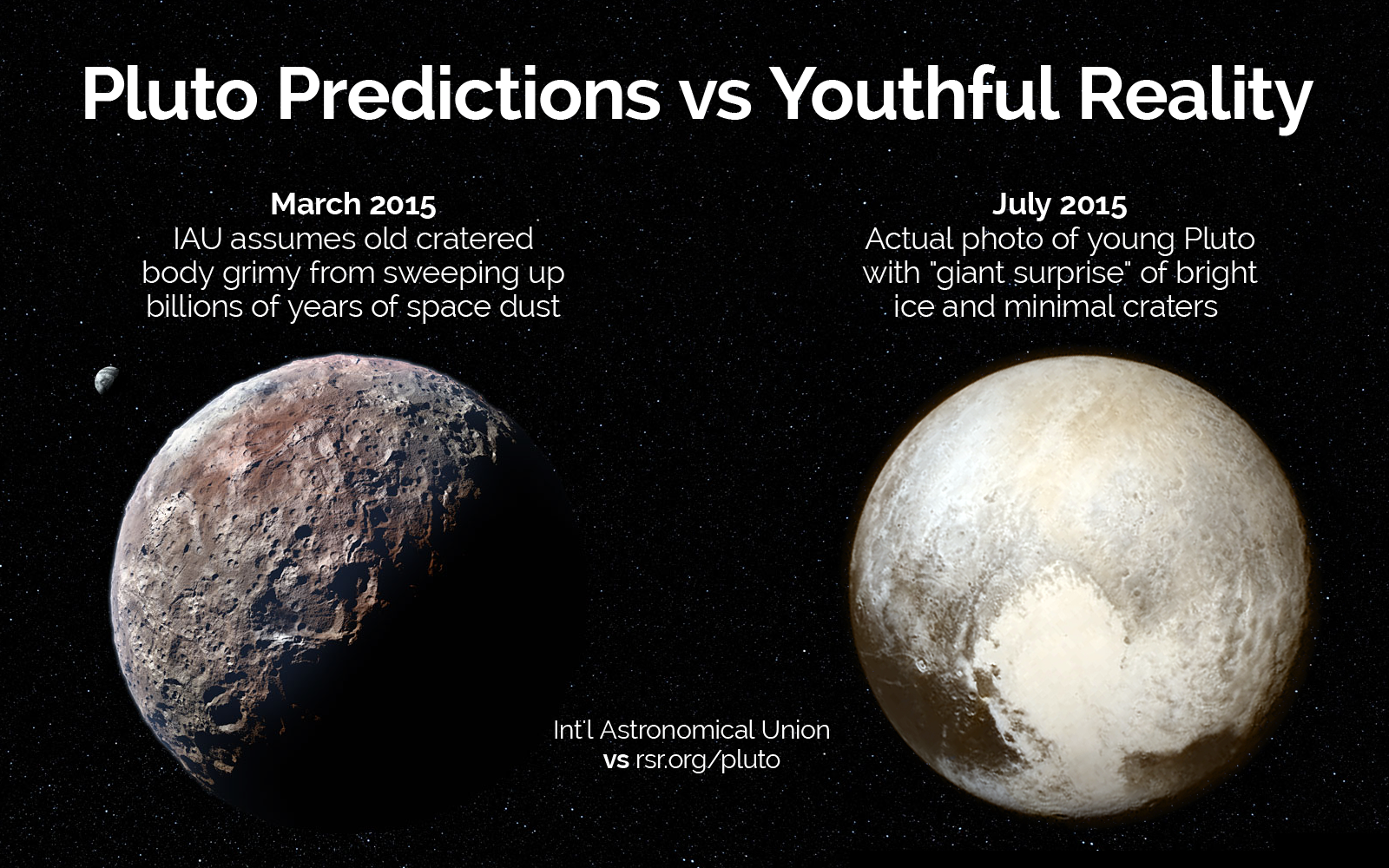[Originally published as List of the Transient Events in the Solar System]
Listen here for the radio show:
Short-lived events everywhere they shouldn’t be:
(Updated April 13, 2019) Bob Enyart and Fred Williams present Real Science Radio’s list of transient (fleeting) events in our solar system that we should not be seeing if the solar system actually were 4.55 billion years old.
By now the solar system should have reached stasis. Instead, scientists observe a great number of short-lived occurrences (transient phenomena) on many of our planets and even their moons, including the rapid decline of magnetic fields (note the plural), of volcanic eruptions, youthful (non-dusted) and changing rings, a still melting inner core, rapidly changing “ancient” features; extremely high heat loss; rapid accumulation of dust; radon, helium, etc., outgassing, massive plumes, and add to all that the transient nature of comets and even of events on many asteroids and trans-Neptunian objects.
Many unexpected transient events in our solar system:
If the solar system actually were 4.55 billion years old (that third significant digit exposes the marketing hype of the evolutionists who commonly add it as a psychological device to convince the public of a fictitious precision), by now it should have reached stasis. Instead, scientists observe a great number of fleeting, short-lived occurrences (transient phenomena) including:
- Mercury: Rapid decline of its magnetic field; “recently” deposited “geologically young” water ice on poles
- Venus: Recent volcanic eruptions and its significant slowing of rotation
- Earth: Rapid decline of magnetic field (2019: even faster?); inner core melting; black smokers; rapidly collapsing “ancient” features; varied temperatures throughout the Earth nowhere near equilibrium (even with majority of radioactivity in the continental crust); radioactive decay uber-concentrated and not yet at steady state; “recently” formed mantle upwelling
- Moon: rsr.org/moon#TLP cites unexpected heat, dust, molten outer core, volcanism, many young craters, ubiquitous micrometeorites, radon & helium emissions, recession, and two major but “temporary” dust clouds gravitationally held in two of the Earth/Moon Lagrange points
- Mars: Eruption of water vapor plumes to 200 kilometers, water on the equator, “inexplicable” methane plumes randomly belch out thousands of tons at a time of this organic gas which “really shouldn’t be there” says NASA’s Chris Webster; and outgassing of its moons Phobos and Deimos
- Jupiter: Moon Europa erupting and Io giving off 10x more heat than tidal pumping can explain
- Saturn: Rings are young & changing; Enceladus is erupting (hear RSR & former JPL system administrator), and ejecting both plasma and Argon 40 (an enormous and impossible amount if formed as generally claimed)
- Comets: The European Space Agency was surprised to film an actual landslide on the allegedly four billion year-old Comet 67P flying pile of rounded boulders and ice that is also outgassing oxygen; also, short-period comets exist even though the Oort cloud does not! See more at rsr.org/comets.
- Asteroids: NASA surprised to catch an asteroid breaking up, while in 2019 it caught allegedly 4-billion year-old tiny Bennu outgassing, just as others outgas including the large Ceres at 13 pounds of water vapor per second and the small binary comet/asteroid Body 288P, and some even look like comets, with one having six tails, etc., see phys.org, NASA, EarthSky, etc., and a retrograde one that barely missed hitting Jupiter for… billions of years? See more at rsr.org/asteroids.
- TNOs: Trans-Neptunian Objects are thousands of years old because millions of years would have randomized their perihelions. See more at rsr.org/TNOs.
- TNO Pluto: Pluto’s smooth, youthful appearance was not expected considering its alleged 4-billion-year age.

Evolutionary Astronomy Hinders Science:
Mainstream astronomers constantly use the term “evolution” to describe their field. Evolutionary astronomers though lack curiosity about amazing scientific discoveries that fundamentally challenge their materialist framework. For example, despite the astounding transient events of the solar system, cataloged above, The Encyclopedia of the Solar System, Third Edition, the mammoth 2014 “definitive work in this field”, published by Elsevier, fails to index transient events.
More Mars News: NASA finds that Mars, “once had 1-mile deep oceans and STILL remains moist“.
Transient events in the universe!
Do you know the name of the quasar that grew tenfold brighter, not over millions but in only one year? If so, you may be just the kind of person who could help with RSR research (see rsr.org/research-team)! For example, Icarus, the furthest individual star ever seen (possibly because of galaxy cluster lensing) grew bright enough in 2016 for Hubble astronomers to spot it. See also in Nature Astronomy, 2018, “Two peculiar fast transients…” If you can find an example that fits any of the following, please email your finding to Bob@rsr.org:
- a transient event in our solar system but not mentioned above
- a transient event outside of our solar system but within the Milky Way
- a transient event outside of the Milky Way but somewhere within the universe
- a universe-wide transient event (per Lawrence Krauss maybe?)
Possible Sirius color change: The star Sirius presents one possible example of a transient event outside of our solar system. The brightest star in the sky other than the Sun, today Sirius shines bluish-white, but less than 2,000 years ago it was described as reddish in color. Depending upon the reliability of Ptolemy, Aratus, Cicero, Germanicus, Seneca, and St. Gregory of Tours, not many centuries ago Sirius was reddish, unless they were mistakenly identifying a different star (Arcturus?) or they were attributing to the inherent color of Sirius the effects of Earth’s atmosphere at the star’s rising.
However, ignoring the Creator and His Word and assuming materialist timeframes, secular astronomers admit that, “the timescale of thousands of years is too short” for Sirius to change color.
Earth’s rapidly collapsing “ancient” features: A new list program, RSR’s List of Earth’s Collapsing “Ancient” Features, has grown out of this program. What’s the point of it?
If the Earth’s geological tourist attractions of structures like spires and arches actually were ancient, then mathematically, we would not expect to see gravity destroying so many of them so rapidly. The old-earth model and its rejection of the global flood is challenged by the observation that on average over the past half-century, about one collapse of a notable arch, etc., occurs per year while no similar rate of offsetting arches are being formed. At our Collapsing Features link, see for example:
- The Old Man of the Mountain, New Hampshire, formation on a cliff formed in the Ice Age that allegedly began two million years ago but that eroded into the face allegedly about 19,000 years agobut collapsed on May 3, 2003.
- God’s Finger, Canary Islands, Spain (El Dedo de Dios) allegedly formed over about 250,000 years from rock laid down 14 million years ago, and fell in November 2005.
- Nye Beach, Oregon’s massive, 100-foot-tall Jump-Off Joe formed perhaps as late as the 1800s but, according to the United States Geological Society, in middle Miocene sandstone that had allegedly been laid down 16M – 11.6 million years ago. Joe collapsed in 1916 and has completely eroded away.
- The 50-foot tall Cobra Rock formation near Moab, according to geology.utah.gov was capped with an allegedly 245-million year old sandstone slab over it’s allegedly 290-million year old body, all of which fell in July 2014.
- A 70-foot long slab fall off of Landscape Arch: Over the last few decades, three heavy slabs of rock have fallen off Moab, Utah’s Landscape Arch, one 30 feet in length, another 47 feet long, and this 70-foot long chunk…
And this… Cornwall, UK’s North Cliffs Collapse: Wow! See thousands of tons of rock fall off of North Cliffs.
And this… The tragic September 2017 rockfalls at Yosemite’s El Capitan that injured and killed workers and tourists. Hear Bob Enyart discuss this on air and check out this excerpt from the LA Times:
In more than a century of record-keeping, rockfalls at Yosemite have resulted in at least 17 fatalities, 85 injuries and damage to buildings… As scientists have come to learn, the domes and arches carved into the park’s famed granite cliffs are constantly moving, according to a study published last year in Nature Geoscience. “Granite rocks, any kind of rock, is more dynamic than people realize — pieces are falling off, they’re constantly changing,” Yager said. “Over the course of the years, these features gradually loosen … until one day, it’s just a catastrophic release.” …the U.S. Geological Survey and the National Park Service have found a potential cause for the seemingly spontaneous rockfalls: heat. As the temperature rises from morning to afternoon, the thin outer layer of rock moves ever so slightly away from the cliff, then returns as the evening cools.
Note also that the same relentless physical reality that tears apart rocks does the same thing to slender biological molecules within fossils! Gradual changes in temperature, even in the ground, expand and contract the polymer chains that protein and DNA are comprised of. Over time, by the physics of heat transfer, being hit by radioactive decay, and chemical processes, biomatter in fossils decompose. Yet allegedly million and hundred-million and even billion-year-old fossils have plenty of still-biological endogenous tissue and other biomaterial! See tiny.cc/biomaterial-fossils-list and rsr.org/dino-soft-tissue.







